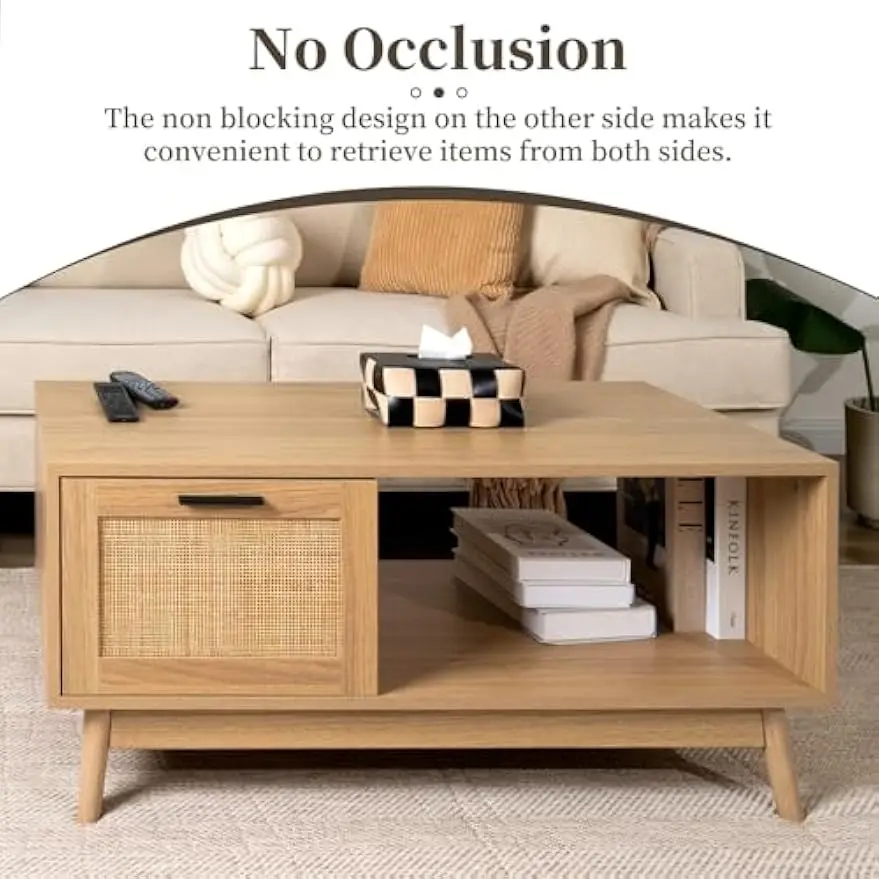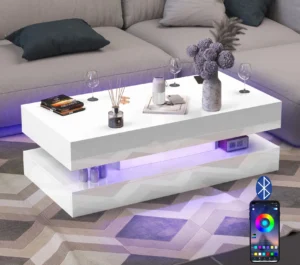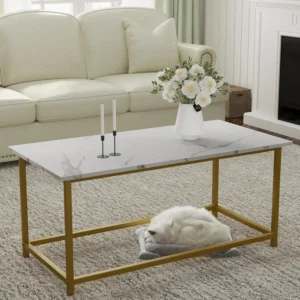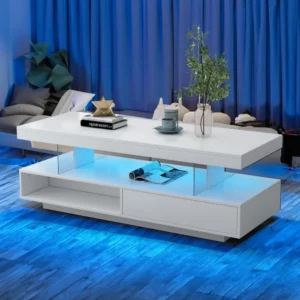Introduction to Rectangular Mid-Century Coffee Tables
The mid-century modern design movement represents one of the most influential periods in furniture history. Characterized by clean lines, functional design, organic forms, and minimal ornamentation, mid-century pieces continue to captivate homeowners and designers alike. Among these pieces, the rectangular coffee table stands as perhaps the most iconic centerpiece for any living room.
Coffee tables serve as both functional surfaces and aesthetic anchors in your living space. They’re where you place drinks, books, remote controls, and decorative items. They also connect different seating elements and help define the room’s flow. A well-chosen rectangular coffee table can transform your entire living area, providing both practical utility and visual appeal.
The enduring popularity of rectangular coffee table design features speaks to their incredible versatility. These tables work beautifully in spaces of various sizes and pair harmoniously with furniture of different styles. Whether your home leans contemporary, traditional, or eclectic, a rectangular mid-century coffee table can elevate the entire aesthetic.
In this comprehensive guide, you’ll discover:
– How to select the perfect mid-century coffee table based on materials, size, and budget
– The distinctive design elements that define authentic mid-century pieces
– Styling tips to maximize your table’s impact in your space
– Care instructions to ensure your investment lasts for decades
At Hearth Forms, we specialize in curating authentic mid-century design pieces that honor the tradition of functional art while meeting contemporary needs for quality and durability.
Why Rectangular Mid-Century Coffee Tables Remain Popular
The enduring popularity of rectangular mid-century coffee tables isn’t simply about following design trends—it’s about their incredible versatility and functionality. Unlike round or square tables, rectangular tables efficiently utilize space in most living room layouts, particularly those with standard sofa arrangements.
These tables offer the perfect balance of form and function. Their elongated shape provides ample surface area for books, beverages, and decorative objects while maintaining visual lightness. The clean, simple lines characteristic of mid-century design complement virtually any interior style, from minimalist modern to eclectic bohemian.
The differences between rectangular and square coffee tables become most apparent when considering spatial flow. Rectangular tables naturally create directional movement in a room, guiding the eye and creating visual interest. They can make smaller spaces appear larger by emphasizing length rather than width.
What makes rectangular mid-century coffee tables particularly special is their timelessness. While other furniture trends come and go, these pieces have remained relevant for over half a century. Interior designers consistently feature them in publications and projects because they:
- Provide excellent functionality for everyday use
- Create visual harmony with various seating arrangements
- Adapt easily to changing design preferences
- Balance distinctive character with understated elegance
- Offer ideal proportions for standard living spaces
Essential Materials Used in Authentic Mid-Century Coffee Tables
The materials used in mid-century coffee tables are fundamental to their character and authenticity. Understanding these materials helps you recognize quality and make informed choices when selecting your piece.
Wood Options
Walnut: Perhaps the quintessential mid-century wood, walnut features a rich, dark color palette ranging from chocolate brown to purple-black streaks. Its straight grain offers visual interest without overwhelming patterns. Walnut’s natural durability and resistance to warping make it ideal for furniture that needs to last generations.
Teak: Prized for its beautiful honey-amber tones, teak contains natural oils that make it exceptionally resistant to moisture, rot, and insects. This tropical hardwood develops a silver-gray patina over time if left untreated, though most mid-century modern teak coffee tables maintain their warm glow through occasional oiling.
Oak: Strong and resilient with a distinctive grain pattern, oak provides excellent structural integrity. While less common than walnut in original mid-century pieces, it offers a lighter color palette that works well in contemporary interpretations.
Ash: With its light color and prominent grain, ash brings brightness to mid-century designs. Its exceptional flexibility allows for the organic curves seen in many iconic pieces, while its strength ensures long-term durability.
Glass Elements
Glass surfaces became popular in mid-century design for their ability to create visual lightness. Tempered safety glass, which shatters into small, relatively harmless pieces if broken, was commonly used for tabletops. Designers often employed clear glass to showcase sculptural wooden bases, while smoked glass added sophistication and visual depth.
Metal Accents
Brass: Offering warm golden tones, brass accents provide elegant contrast to wood elements. Often found on table legs, drawer pulls, or inlays, brass develops a beautiful patina over time.
Chrome: With its mirror-like finish, chrome brings a sleek, reflective quality to furniture. Chrome-plated steel legs became iconic elements in many mid-century designs.
Powder-coated steel: Durable and available in various colors, powder-coated steel allowed designers to introduce bold hues while maintaining structural integrity.
The thoughtful combination of these materials defines authentic mid-century modern solid wood coffee tables. Wood provides warmth and organic appeal, glass creates visual space, and metal accents add contrast and structural support—all working together to achieve that perfect balance of form and function.
Selecting the Right Size and Proportions
Finding the perfect rectangular coffee table isn’t just about style—proportions matter tremendously. A table that’s too large overwhelms your space, while one that’s too small fails to serve its purpose effectively. Follow these guidelines to achieve ideal balance in your living area.
The standard height for coffee tables ranges from 16-18 inches (40-46 cm), ideally sitting 1-2 inches below your sofa seat height. This ensures comfortable reach while maintaining visual harmony. For length, a good rule of thumb is selecting a table approximately two-thirds the length of your sofa. This provides adequate surface area without overwhelming the seating arrangement.
When considering width, allow 12-18 inches (30-45 cm) between the table edge and seating. This provides comfortable legroom while keeping the table within easy reach. Additionally, maintaining 18-24 inches (45-60 cm) of walking clearance around the arrangement ensures smooth traffic flow.
Mastering space planning for long rectangular tables depends on understanding how your specific room dimensions interact with your furniture. Consider these recommendations based on sofa size:
| Sofa Size | Recommended Table Length | Recommended Table Width |
|---|---|---|
| Small (6 ft/1.8 m) | 36-42 inches (90-107 cm) | 18-22 inches (45-56 cm) |
| Medium (7-8 ft/2.1-2.4 m) | 42-48 inches (107-122 cm) | 20-24 inches (51-61 cm) |
| Sectional/Large (9+ ft/2.7+ m) | 48-60 inches (122-152 cm) | 24-30 inches (61-76 cm) |
Remember that these guidelines are starting points. Your specific room layout, traffic patterns, and personal needs should inform your final decision. For open-concept spaces, you might prefer a slightly larger table that defines the seating area. In compact apartments, consider tables with narrower profiles to maintain necessary clearance.
Don’t forget that your coffee table exists in relation to other pieces. Ideally, end tables should be within 3 inches (7.5 cm) of the same height as your coffee table to create visual cohesion while maintaining functionality.
Distinctive Design Elements of Mid-Century Coffee Tables
The beauty of mid-century coffee tables lies in their thoughtful design details that combine aesthetics and functionality. Understanding these key design traits of rectangular coffee tables helps you identify authentic pieces and appreciate their craftsmanship.
Leg Styles
Tapered Legs: One of the most recognizable elements of mid-century design, tapered legs narrow elegantly from top to bottom. This subtle detail creates visual lightness while maintaining structural integrity. Typically angled outward slightly, these legs offer both stability and dynamic energy.
Hairpin Legs: Made from bent metal rods, hairpin legs exemplify minimalist design principles. Their thin profile creates an illusion of the tabletop floating, perfect for smaller spaces where visual openness matters.
Splayed Legs: Angled outward from the table’s center, splayed legs provide exceptional stability while creating a distinctive silhouette. This design element speaks to the organic, space-age influence prevalent during the mid-century era.
Storage Features
Mid-century designers understood the importance of functionality alongside beauty. Many coffee tables incorporate clever storage solutions:
Hidden Drawers: Seamlessly integrated drawers provide discreet storage for remote controls, coasters, and other small items while maintaining clean lines.
Open Shelving: Many designs feature a second tier beneath the main surface—perfect for displaying books, magazines, or decorative objects while keeping the tabletop uncluttered.
Magazine Racks: Some tables include built-in compartments specifically designed for periodicals, reflecting the era’s appreciation for print media.
Surface Designs
Integrated Trays: Recessed sections or removable trays help contain smaller items and add visual interest to the tabletop.
Geometric Inlays: Wood veneers arranged in striking patterns showcase exceptional craftsmanship and add visual texture without ornate decoration.
Two-Tiered Surfaces: Secondary surfaces at different heights create visual interest while providing additional functionality.
Raised Edges: Subtle lips around table edges prevent items from falling off while adding a distinctive design detail.
These thoughtful elements aren’t merely decorative—they reflect the mid-century philosophy that beautiful objects should also be useful. Each feature serves both aesthetic and practical purposes, creating furniture that remains relevant and functional decades after its design.
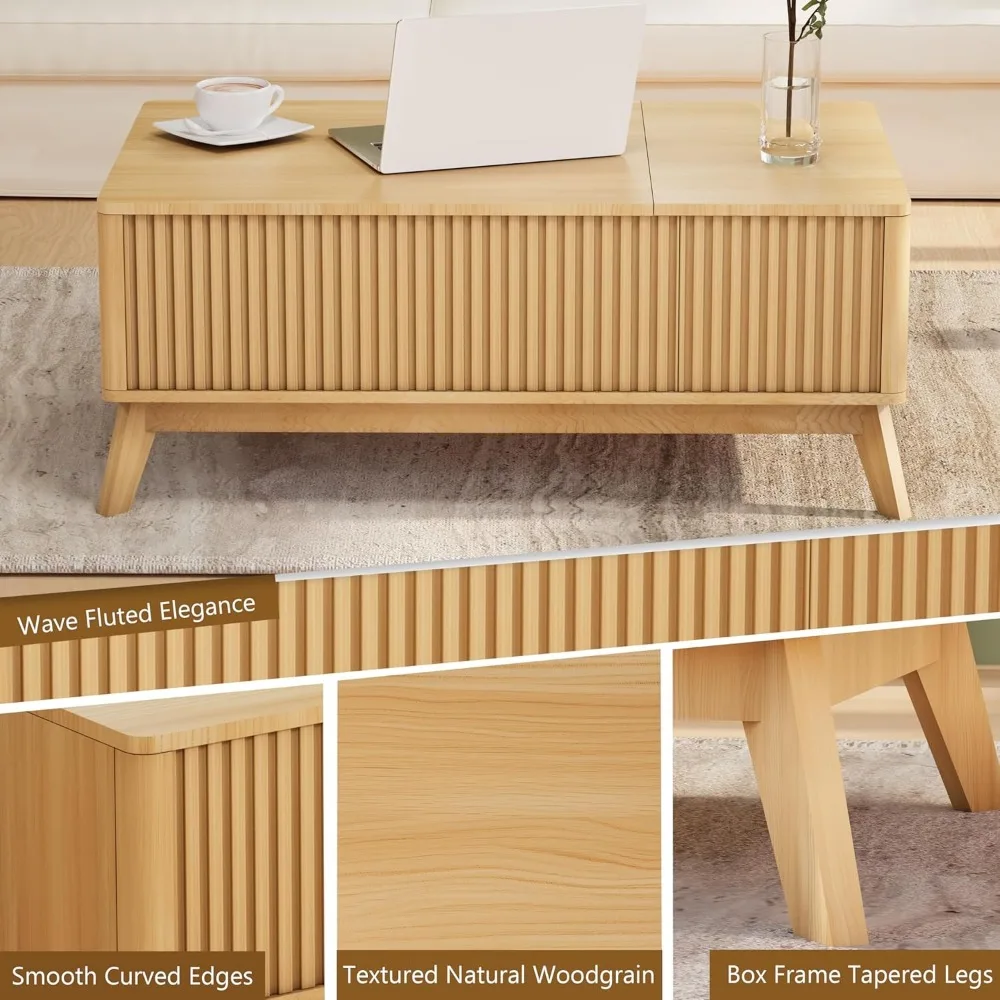
Evaluating Construction Quality and Craftsmanship
The difference between a good mid-century coffee table and an exceptional one often comes down to construction quality. Understanding what to look for helps you make a wise investment that will last for generations.
Quality joinery represents perhaps the most important indicator of craftsmanship. Traditional woodworking techniques create stronger, more durable connections than modern shortcuts. Look for:
- Dovetail joints: These interlocking “puzzle piece” connections, visible in drawers and corners, provide exceptional strength without requiring nails or screws.
- Mortise and tenon: This ancient technique creates incredibly strong joints by fitting a projecting piece (tenon) into a corresponding cavity (mortise).
- Finger joints: These interlocking connections distribute stress across multiple contact points, preventing separation over time.
The material quality directly impacts both appearance and longevity. Solid wood pieces offer superior durability compared to particleboard or MDF with thin veneers. However, high-quality veneers on plywood can provide excellent stability while showcasing beautiful grain patterns. The key is determining whether veneers are substantial enough to withstand refinishing.
Hardware quality often reveals a manufacturer’s commitment to excellence. Drawer glides should operate smoothly, hinges should function without catching, and any metal elements should feel substantial. Lightweight or poorly fitted hardware suggests corners were cut elsewhere as well.
Mid-century modern teak coffee tables exemplify craftsmanship through their weight and stability. Quality tables feel solid—not just heavy, but balanced and planted. Check for wobbling or uneven legs, which indicate poor construction.
Surface finishing reveals meticulous attention to detail. Run your hand across surfaces to feel for consistent smoothness. Examine edges and corners for uniform rounding. High-quality finishes penetrate the wood rather than merely coating the surface, offering better protection and a more natural appearance.
Hand-crafted elements like carved details, precision inlays, or custom hardware indicate special attention to design integrity. These touches not only enhance aesthetics but often reflect overall quality standards throughout the piece.
Budget Considerations: What to Expect at Different Price Points
Understanding the relationship between price and quality helps you make informed decisions when investing in a rectangular mid-century coffee table. Each price range offers distinct advantages and compromises worth considering.
Entry-Level Options ($200-500/£160-400)
At this price point, you’ll primarily find reproductions using engineered woods with veneers rather than solid hardwoods. While these pieces capture mid-century aesthetics, they typically feature simplified construction methods:
- Veneer over particleboard or MDF construction
- Basic hardware that functions adequately but lacks refinement
- Machine-made rather than hand-finished elements
- Simplified versions of classic designs
- Acceptable durability for medium-term use (5-7 years)
These tables work well for those just beginning to explore mid-century style or furnishing temporary living situations.
Mid-Range Selections ($500-1,200/£400-950)
This category represents the sweet spot for many buyers, offering substantial improvements in materials and craftsmanship:
- Higher quality veneers on plywood cores or partial solid wood construction
- Better joinery techniques for improved stability
- More attention to authentic design details
- Hand-finished elements
- Good durability for long-term use (10-15+ years)
Mid-range tables from reputable manufacturers deliver excellent value by balancing quality construction with reasonable pricing. The mid-century modern rectangular coffee tables in this category often provide the best balance of authenticity and affordability.
High-End and Investment Pieces ($1,200+/£950+)
Premium tables justify their price through exceptional materials and craftsmanship:
- Solid hardwood construction throughout (often old-growth or sustainably harvested)
- Traditional joinery techniques (dovetail, mortise and tenon)
- Hand-rubbed finishes with multiple layers
- Precise attention to authentic proportions and details
- Premium hardware with smooth operation
- Heirloom quality with potential for multi-generational use (20+ years)
These investment pieces often come from established manufacturers with decades of experience or boutique woodworkers specializing in authentic reproductions or original designs. Their value typically appreciates over time, especially for authenticated vintage pieces from noted designers.
When determining your budget, consider not just the initial purchase price but the total cost of ownership. Quality pieces require less frequent replacement, potentially making them more economical over decades of use. Additionally, premium tables typically offer better resale value should your needs or preferences change.
Our Selection: Best Overall Rectangular Mid-Century Coffee Table
After extensive evaluation of materials, construction, design authenticity, and value, our top overall recommendation exemplifies the perfect balance of form, function, and quality craftsmanship. This rectangular mid-century coffee table delivers exceptional performance across all critical categories.
Crafted from solid walnut with a hand-rubbed oil finish, this table showcases the wood’s natural beauty while providing exceptional durability. The warm, rich tones develop additional character over time, creating a piece that looks even better with age. At 47 inches × 23 inches × 16 inches (120 cm × 58 cm × 41 cm), it provides ample surface area without overwhelming most living spaces.
The tapered legs, set at the perfect angle, create the visual lightness characteristic of authentic mid-century design. This subtle detail—combined with the table’s perfectly balanced proportions—makes it appear to float despite its substantial construction. The precision joinery at each leg connection demonstrates exceptional craftsmanship, ensuring decades of stable use.
What truly distinguishes this piece is its versatility across interior styles. While undeniably mid-century in its DNA, its clean lines and organic form complement everything from contemporary minimalist spaces to eclectic bohemian settings. The simple silhouette allows it to enhance rather than compete with your existing furniture.
The tabletop thickness of 3/4 inch (1.9 cm) provides ideal stability without appearing bulky. Its edges feature subtle rounding that’s comfortable against the skin—a thoughtful detail often overlooked in lesser reproductions. The surface can handle daily use while remaining beautiful with minimal maintenance.
With its combination of authentic design, quality materials, expert craftsmanship, and versatile aesthetics, this table represents an excellent investment in both style and functionality.
Best Budget-Friendly Rectangular Mid-Century Coffee Table
Finding an affordable rectangular mid-century coffee table doesn’t mean sacrificing style. Our budget-friendly recommendation delivers impressive aesthetics and functionality without stretching your wallet.
This table features a walnut veneer over an engineered wood core—a smart compromise that provides the beautiful grain patterns of walnut while keeping costs manageable. At 43 inches × 20 inches × 16 inches (109 cm × 51 cm × 41 cm), it offers proper proportions for apartments and smaller living rooms while maintaining authentic mid-century scale.
The tapered splayed legs capture classic mid-century character while providing good stability. Though made from rubberwood rather than solid walnut, they’re stained to match the tabletop veneer, creating a cohesive appearance. The legs attach via metal hardware rather than traditional joinery—practical for shipping and assembly while maintaining a clean look.
What makes this table stand out in the $200-350 (£160-280) range is its attention to proportions. Many budget options appear chunky or poorly balanced, but this model maintains the visual lightness essential to mid-century design. The modest shelf beneath the tabletop offers practical storage while reinforcing the table’s structural integrity.
To maximize this table’s potential:
– Position it in areas with consistent temperature and humidity to prevent veneer issues
– Use coasters and placemats to protect the surface from moisture and heat
– Add a few authentic mid-century accessories to enhance its presence
– Consider it for spaces where you anticipate changing your furniture within 5-7 years
While it lacks the heirloom quality of higher-priced options, this table delivers authentic mid-century style that works well for first-time homeowners, renters, or those furnishing secondary living spaces.
Premium Pick: High-End Rectangular Coffee Table
For those seeking exceptional quality and authentic craftsmanship, our premium recommendation represents the pinnacle of mid-century coffee table design. This investment-quality piece merits its higher price through extraordinary materials, construction techniques, and design integrity.
Crafted from solid, hand-selected walnut from sustainably managed forests, this table showcases the material’s stunning natural grain patterns. The mid-century modern walnut coffee tables in this category feature boards carefully matched for color and grain continuity, creating a visually harmonious surface. At 52 inches × 26 inches × 15 inches (132 cm × 66 cm × 38 cm), it provides generous surface area while maintaining elegant proportions.
The construction quality sets this table apart from lesser options. Traditional woodworking techniques include hand-cut dovetail joints in the concealed drawer and authentic mortise-and-tenon connections at each leg. These methods ensure exceptional structural integrity without visible fasteners, allowing the design’s clean lines to remain uninterrupted.
The hand-applied oil-and-wax finish highlights the walnut’s natural beauty while providing excellent protection. Applied in multiple layers with careful sanding between each coat, this labor-intensive process creates a surface with remarkable depth and subtle luster that mass-produced tables simply cannot match.
Design details reveal extraordinary attention to authenticity. The precisely angled tapered legs feature subtle sculpting at the connection points—a hallmark of genuine mid-century craftsmanship. The tabletop edges incorporate a delicate “knife edge” profile that appears impossibly thin while remaining structurally sound.
Priced between $1,200-2,500 (£950-2,000), this table represents a significant investment. However, its heirloom quality construction ensures it will serve multiple generations, potentially becoming more valuable over time. For connoisseurs of authentic mid-century design, this level of quality and craftsmanship justifies the premium price.
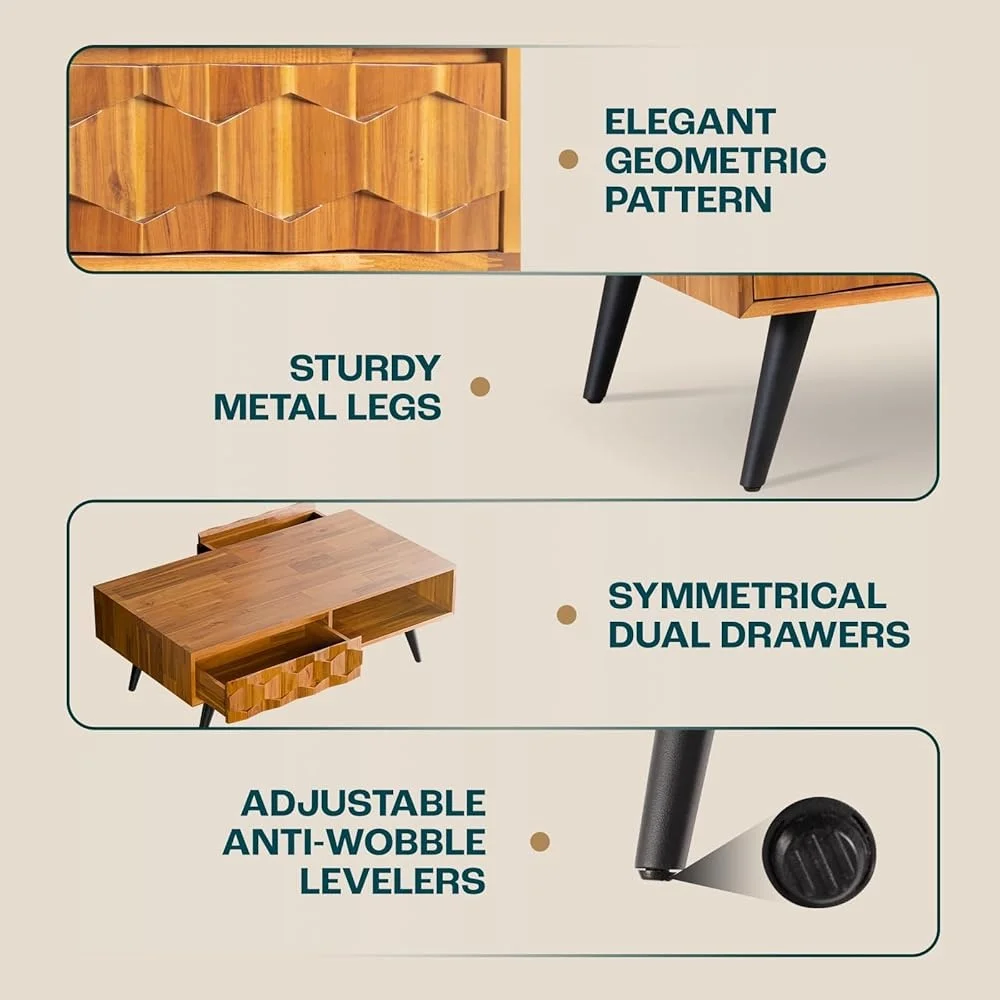
Best Rectangular Coffee Table with Built-in Storage
For those seeking both style and functionality, our storage-focused recommendation delivers exceptional organization capabilities while maintaining authentic mid-century aesthetics. This thoughtfully designed piece addresses practical needs without compromising design integrity.
This table features two spacious drawers with smooth gliding hardware, providing discreet storage for remotes, gaming controllers, coasters, and other living room essentials. The drawer fronts integrate seamlessly into the design, maintaining clean lines when closed. At 48 inches × 24 inches × 17 inches (122 cm × 61 cm × 43 cm), it provides ample surface area while accommodating significant storage capacity.
Constructed from solid oak with walnut accents, this table offers durability where it matters most. The slightly higher 17-inch height improves accessibility to the drawers while remaining proportionate to standard sofa heights. The drawers themselves feature dovetail joinery and solid wood construction—quality touches that ensure smooth operation for decades.
What distinguishes this table from other storage options is how it maintains authentic mid-century proportions despite its functionality. Many storage-focused tables appear bulky, but this design preserves visual lightness through tapered legs and a recessed base that creates a floating effect. The lift-top coffee tables offer additional functionality while maintaining clean lines.
Perfect for smaller living spaces where every square inch matters, this table helps reduce clutter while providing a stylish focal point. The drawers accommodate standard-sized board games, making it ideal for entertainment areas. The solid construction supports up to 150 pounds (68 kg), allowing it to handle everyday use with ease.
Priced between $400-800 (£320-640), this table delivers excellent value considering its dual functionality as both surface and storage. The quality construction and thoughtful design make it a practical investment for anyone seeking to maximize their living space without sacrificing style.
Mid-Century Modern Solid Wood Coffee Tables, Mid-Century Modern Teak Coffee Tables
$879.95 Select options This product has multiple variants. The options may be chosen on the product pageMid-Century Modern Danish Coffee Tables, Mid-Century Modern Oval Coffee Tables, Mid-Century Modern Solid Wood Coffee Tables
$390.05 Select options This product has multiple variants. The options may be chosen on the product pageMid-Century Modern Lift Top Coffee Tables, Mid-Century Modern Square Coffee Tables
$454.73 Select options This product has multiple variants. The options may be chosen on the product pageMid-Century Modern Large Coffee Tables, Mid-Century Modern Rectangular Coffee Tables
$603.26 Select options This product has multiple variants. The options may be chosen on the product pageMid-Century Modern Marble Top Coffee Tables, Mid-Century Modern Rectangular Coffee Tables, Mid-Century Modern White Coffee Tables
Price range: $163.28 through $189.22 Select options This product has multiple variants. The options may be chosen on the product pageMid-Century Modern Rectangular Coffee Tables, Mid-Century Modern White Coffee Tables
$605.68 Select options This product has multiple variants. The options may be chosen on the product page
Best Rectangular Glass-Top Mid-Century Coffee Table
For those seeking to create visual spaciousness while maintaining mid-century character, our glass-top recommendation offers the perfect solution. This sophisticated table combines material transparency with solid structural elements to achieve a balanced, lightweight presence.
The 3/8-inch (10 mm) tempered safety glass top provides a durable, easy-to-clean surface that visually expands your space. This thickness offers excellent stability without appearing excessively heavy. The glass features polished edges with subtle rounding for both safety and aesthetic refinement. At 46 inches × 22 inches × 16 inches (117 cm × 56 cm × 41 cm), it provides ample surface area while maintaining appropriate scale for most living rooms.
The base showcases solid walnut construction with the distinctive geometric forms characteristic of mid-century design. The sculptural wooden framework provides both structural support and visual interest, creating a beautiful interplay between transparency and solidity. The precision joinery at each connection point demonstrates exceptional craftsmanship.
What makes this table particularly successful is how it balances mid-century authenticity with contemporary sensibilities. The combination of glass and wood feels timeless rather than trendy, allowing it to complement various interior styles. The glass top creates a perfect display opportunity for the architectural base while providing a practical surface for daily use.
This table works exceptionally well in:
– Apartments and smaller spaces where visual openness matters
– Rooms with statement rugs you want to remain visible
– Settings with dramatic lighting you wish to highlight
– Contemporary interiors seeking a touch of warmth
Priced between $350-700 (£280-560), this glass-top option delivers sophisticated style with practical benefits. The tempered safety glass resists scratches and breaks, while the solid wood base provides stability and authentic mid-century character. For regular maintenance, standard glass cleaner keeps the surface spotless, while occasional wood conditioning preserves the base’s beauty.

Comparison Table: Top Rectangular Mid-Century Coffee Tables
| Feature | Best Overall | Budget-Friendly | Premium Pick | Built-in Storage | Glass-Top |
|---|---|---|---|---|---|
| Materials | Solid walnut | Walnut veneer over engineered wood | Solid walnut (premium selection) | Solid oak with walnut accents | Tempered glass with solid walnut base |
| Dimensions | 47”×23”×16” (120×58×41 cm) | 43”×20”×16” (109×51×41 cm) | 52”×26”×15” (132×66×38 cm) | 48”×24”×17” (122×61×43 cm) | 46”×22”×16” (117×56×41 cm) |
| Price Range | $600-900 (£480-720) | $200-350 (£160-280) | $1,200-2,500 (£950-2,000) | $400-800 (£320-640) | $350-700 (£280-560) |
| Storage | No | Simple shelf | Hidden drawer | Two full-width drawers | No |
| Weight Capacity | 100 lbs (45 kg) | 65 lbs (29 kg) | 120 lbs (54 kg) | 150 lbs (68 kg) | 75 lbs (34 kg) |
| Unique Features | Perfect proportions, exceptional finish | Great value, easy assembly | Hand-cut joinery, premium finish | Smooth drawer glides, practical storage | Visual lightness, showcase base |
| Best For | Most living spaces, long-term investment | First apartments, temporary settings | Design enthusiasts, collectors | Small spaces, families, multifunctional rooms | Contemporary settings, smaller rooms |
Styling Your Mid-Century Coffee Table: Design Tips
Your rectangular mid-century coffee table serves as both a functional surface and a design statement. Styling it effectively enhances its impact while maintaining its usability. Follow these principles to create a balanced, visually appealing arrangement.
The rule of three creates visual harmony on any surface. Group items in odd numbers—particularly threes—for a naturally balanced composition. Vary the heights of your objects to create visual movement across the table. A tall vase or sculpture, a medium-height stack of books, and a low bowl or tray creates pleasing dimensional contrast.
When arranging items, consider both function and aesthetics. Divide your table into zones: one area for decorative objects, another for functional items like remote controls (perhaps contained in a stylish box or tray), and leave some empty space for drinks or temporary items. This zoning approach maintains organization while preventing a cluttered appearance.
The styling tips for rectangular mid-century tables suggest incorporating authentic period elements to enhance your table’s character. Consider vintage ceramics, brass objects, or art books featuring mid-century artists. These items reinforce the design heritage while personalizing your space.
Balance is essential when styling. If your table features dramatic wood grain or distinctive legs, keep decorative elements simple to avoid competition. Conversely, a simpler table design can support more visually interesting objects. Consider the entire room composition—your coffee table styling should complement rather than compete with nearby furniture.
Seasonal refreshes keep your space feeling current. Maintain your core styling pieces while switching out elements like textiles, botanicals, or decorative objects to reflect seasonal changes. This approach allows you to experiment with trends without committing to major purchases.
For those considering different options, comparing square mid-century coffee tables with rectangular versions can help determine which shape best suits your specific space and needs. Each shape creates different visual effects and offers distinct styling opportunities.
Care and Maintenance for Your Mid-Century Coffee Table
Proper care ensures your mid-century coffee table remains beautiful for generations. Different materials require specific maintenance approaches to preserve their appearance and structural integrity.
Wood Care
For wooden surfaces, dust regularly with a soft, slightly damp cloth, following the direction of the wood grain. Clean spills immediately to prevent staining or water damage. Avoid commercial polish containing silicones, which create build-up over time. Instead, use high-quality furniture wax or specialized wood oil recommended for your specific finish, applying every 6-12 months.
Position your table away from direct sunlight, which can fade and damage wood over time. Use a humidifier in dry environments to prevent wood from cracking or splitting due to moisture loss. Always use coasters under beverages and placemats under hot dishes to protect the surface from rings and heat damage.
Glass Maintenance
For glass surfaces, use a quality glass cleaner or a solution of equal parts white vinegar and water. Spray onto a microfiber cloth rather than directly on the glass to prevent liquid from seeping into seams. Clean regularly to prevent dust buildup, which becomes more difficult to remove over time.
Avoid placing extremely hot items directly on glass, which can cause thermal stress and cracking. Use felt or rubber bumpers on any decorative items placed on glass surfaces to prevent scratches when moving objects. Check and tighten any hardware securing the glass periodically.
Metal Element Care
For brass elements, use specialized brass cleaner and a soft cloth to maintain shine, though many appreciate the natural patina that develops. For chrome and stainless steel, wipe with a damp microfiber cloth and dry immediately to prevent water spots. Apply automobile wax to chrome components once yearly for added protection.
To prevent oxidation on metal components, maintain consistent indoor humidity levels between 40-60%. Avoid touching metal elements with bare hands when possible, as skin oils can accelerate tarnishing.
Preventative Measures
Use felt pads under all decorative items to prevent scratches when objects are moved. Lift rather than drag items across your table surface. Re-tighten hardware every few months, as wood naturally expands and contracts with seasonal changes. For minor scratches in wood surfaces, touch-up markers or stick wax fillers matching your wood tone can disguise damage.
For more significant damage, consult a professional furniture restorer rather than attempting major repairs yourself. Quality mid-century pieces often warrant professional care to maintain their value and appearance.
How to Identify Authentic Mid-Century Design
Whether you’re shopping for vintage pieces or high-quality reproductions, recognizing authentic mid-century design characteristics helps you make informed purchases. These identification techniques ensure you invest in pieces with genuine design integrity.
Authentic mid-century coffee tables feature specific proportional relationships. Look for height-to-width ratios that create visual lightness—typically tabletops appear to “float” above slender legs. Original designs prioritize clean, uninterrupted lines with minimal ornamentation. Any decorative elements serve functional purposes rather than existing purely for embellishment.
In terms of materials, genuine mid-century pieces typically feature solid hardwoods or high-quality veneers on plywood (not particleboard). The wood itself should show natural color variations rather than perfectly consistent tones. Natural oil finishes that enhance grain patterns were favored over thick, glossy polyurethane coatings in authentic pieces.
Construction quality provides significant clues about authenticity. Examine joinery techniques—dovetail drawers, mortise-and-tenon connections, and finger joints indicate traditional craftsmanship consistent with mid-century production methods. Hardware should be simple but substantial, often made from solid brass or steel rather than plated materials.
When evaluating reproductions, distinguish between quality interpretations and poor imitations. Quality reproductions respect original proportions and construction techniques while perhaps utilizing modern sustainable materials. Poor imitations merely mimic surface appearance without understanding the design principles that made original pieces successful.
Some manufacturers established during the mid-century period continue producing their iconic designs today. Research specific makers and their distinguishing characteristics—each major designer had signature elements that identified their work. Many quality reproductions clearly identify themselves as “inspired by” rather than attempting to deceive about their origins.
Remember that authentic mid-century design prioritized functionality alongside aesthetics. Every element serves a purpose—tapered legs provide stability while reducing visual weight, storage features integrate seamlessly rather than appearing as afterthoughts, and materials are selected for both beauty and durability.
Frequently Asked Questions About Mid-Century Coffee Tables
What defines a mid-century modern coffee table?
Mid-century modern coffee tables typically feature clean lines, organic shapes, minimal ornamentation, and functional design. Created roughly during the middle decades of the 20th century, they emphasize honest materials (primarily wood, glass, and metal), tapered legs, and a perfect balance between form and function. The defining characteristics include visual lightness, practical surfaces, and timeless proportions that complement various interior styles.
How do I choose the right size table for my space?
Select a coffee table approximately two-thirds the length of your sofa, with 12-18 inches (30-45 cm) between the table edge and seating. The height should be 1-2 inches below your sofa seat height for comfortable use. Allow 18-24 inches (45-60 cm) of clearance around the arrangement for traffic flow. When comparing round versus rectangle coffee tables, remember that rectangular tables generally provide more usable surface area while round tables allow easier movement in tighter spaces.
Are reproductions as good as original mid-century pieces?
Quality reproductions can offer excellent craftsmanship while being more accessible than vintage pieces. The best reproductions honor original design principles, proportions, and materials rather than merely copying surface appearance. Vintage originals may offer investment value and authentic patina but often come with higher price tags and potential condition issues. For most homes, a well-made reproduction provides the perfect balance of quality, authenticity, and practicality.
What’s the best material for durability in a coffee table?
Solid hardwoods like walnut, oak, and teak offer exceptional durability for coffee tables. Teak contains natural oils that resist moisture damage, while walnut provides excellent scratch resistance. For glass tops, tempered safety glass offers good durability while preventing dangerous breakage. The most durable tables combine quality materials with excellent construction techniques like traditional joinery rather than relying solely on hardware.
How do I pair a mid-century coffee table with non-mid-century furniture?
Focus on complementary elements rather than perfect matching. Mid-century tables work well with furniture sharing similar clean lines and proportions, regardless of specific style. Consider color harmony—match wood tones with other wooden elements in your space or create intentional contrast. The simple silhouettes of mid-century tables make them surprisingly versatile across design styles from contemporary to traditional.
Why Invest in a Quality Mid-Century Coffee Table
A well-crafted mid-century coffee table represents more than just a furniture purchase—it’s an investment in timeless design that will serve your home for decades. Unlike trendy pieces that quickly feel dated, mid-century tables have demonstrated remarkable staying power through their clean lines, functional design, and exceptional craftsmanship.
The versatility of these tables allows them to evolve with your changing interior preferences. Whether paired with contemporary sectionals, traditional sofas, or eclectic seating arrangements, a quality mid-century coffee table adapts beautifully. This adaptability means you won’t need to replace your table when refreshing your living room’s look—making it a financially sound long-term choice.
Beyond their aesthetic value, premium mid-century tables offer practical benefits through superior construction. Solid hardwoods, precision joinery, and quality finishes ensure these pieces withstand daily use for generations. While mass-produced furniture often requires replacement within 5-7 years, quality mid-century pieces can last decades with proper care.
From an environmental perspective, investing in long-lasting furniture reduces waste and resource consumption. Rather than participating in the cycle of disposable furniture, choosing a quality table that will serve you for 20+ years represents responsible consumption. Many authentic pieces use sustainably harvested hardwoods with natural finishes, further reducing environmental impact.
Perhaps most importantly, a distinctive mid-century coffee table expresses personal appreciation for thoughtful design. These pieces represent a philosophy where form and function achieve perfect harmony—where beauty emerges from purpose rather than superficial decoration. By selecting a quality mid-century table, you bring this design integrity into your daily environment.
Whether you choose an authentic vintage piece, a high-quality reproduction, or a contemporary interpretation of mid-century principles, investing in excellence pays dividends through daily enjoyment and long-term value. A well-chosen coffee table becomes not just furniture but a centerpiece that anchors your living space and enhances your everyday experience.

